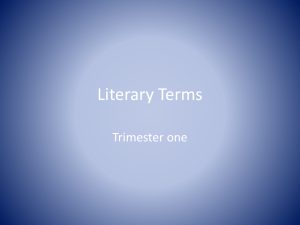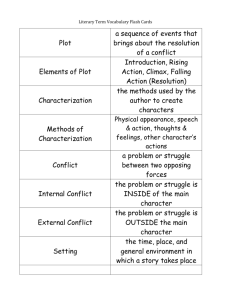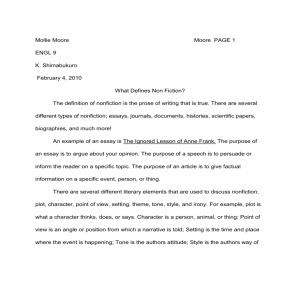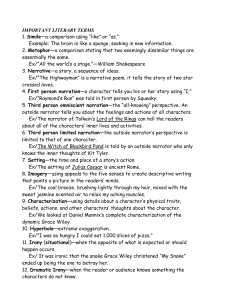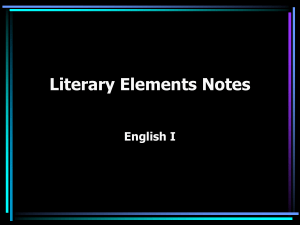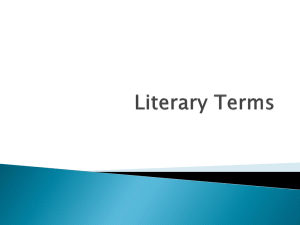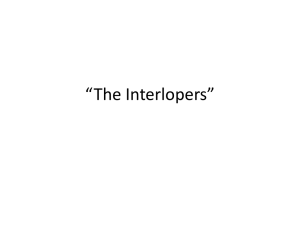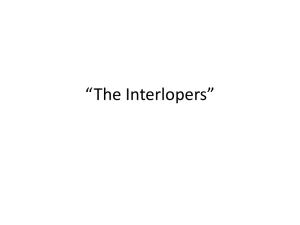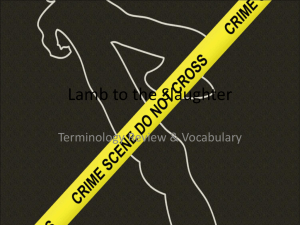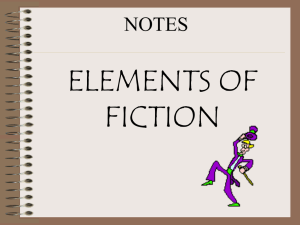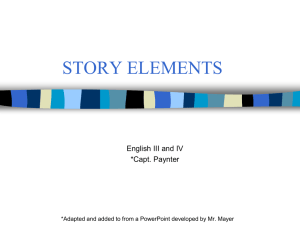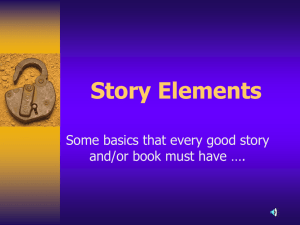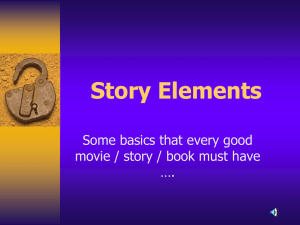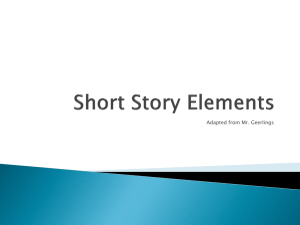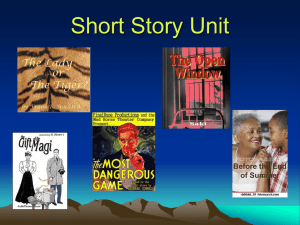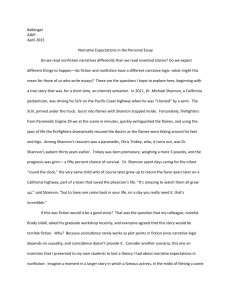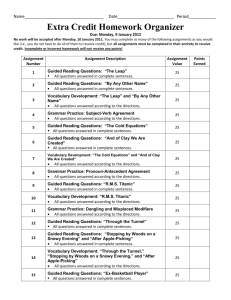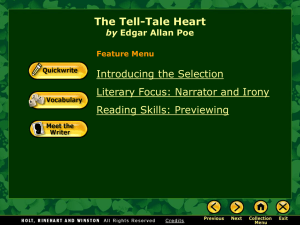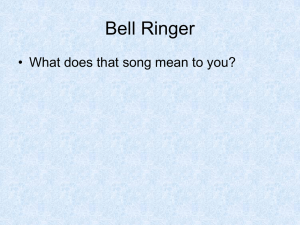Literary Terms
advertisement
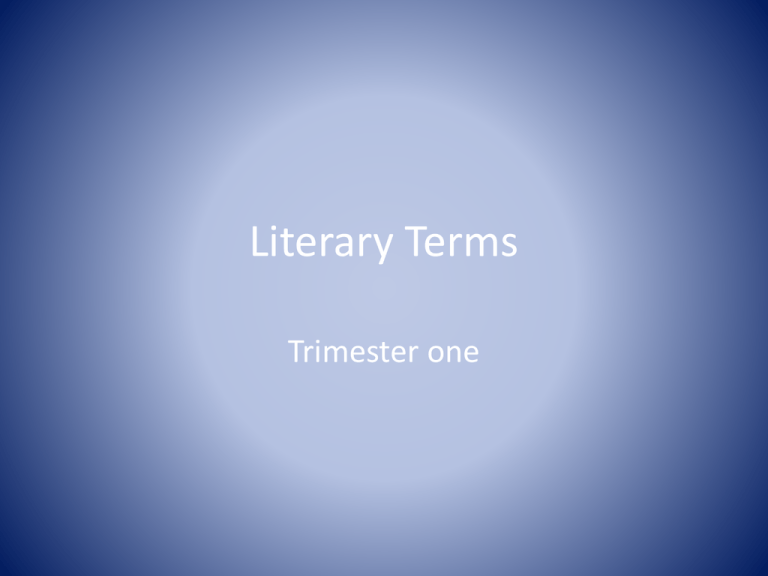
Literary Terms Trimester one Fiction • Something that is made up (not true) (not based on fact). Nonfiction • Prose writing that deals with real people, events, and places without changing any facts. Popular forms of nonfiction are the autobiography, biography, and essay. Non fiction writing can be subjective or objective. Subjective Writing (Nonfiction) • Expresses the feelings and opinions of the writer in addition to giving the facts. Objective Writing (Nonfiction) • Conveys only the facts without introducing any emotion or personal bias. • (bias is a predisposition either for or against something) Protagonist • The main character or hero of the story. Antagonist • The person or thing opposing the protagonist or hero. When this is a person, he or she is usually called the “villain.” Foreshadowing • Hints or clues as to what may happen later. It is used to build suspense or create anxiety. Setting • When and where the story takes place (time and place). Characterization • The method an author uses to reveal his characters and their personalities. 1. An author may describe the character’s physical traits and personality. (ex. Karen was small for her age and inclined to plumpness. Her blue eyes viewed the people and events around her with a mixture of curiosity and amusement. Characterization (continued) 2. An author may report the character’s speech and behavior. (ex. “But why can’t I go?” Karen wailed. Karen wheeled around and stormed out of the house, slamming the door behind her.) 3. An author may give opinions and reactions of other characters toward this individual. (ex. “I’ve known Karen for a long time, ever since Characterization (continued) first grade. We’ve been best fiends since last year. I like her because she’s always so happy and sure of herself.”) 4. An author may reveal the character’s thoughts and feelings. (ex. The sunlight trickled between the slats of the bamboo blinds. Karen thought that she really ought to get up. Sally was coming over at eleven. Maybe she should make some sandwiches so they could eat in the backyard.) Satire • The author pokes fun at people and society in order to produce some change in attitude or action. Point of View (POV) • Relationship between the narrator (person telling the story) and the story he/she tells. The author’s choice of narrator determines the amount of information a reader will be given. First Person Point of View • The narrator (I) is a character in the story who can reveal only personal thoughts and feelings and what he/she sees and is told by the other characters. Third Person Point of View • Third person limited: The narrator is an outsider who only reports what he/she sees or sees into the mind of one of the characters. • Third person omniscient: The narrator is an all-knowing outsider who can enter the minds of more than one of the characters. Theme • The idea about life revealed in a work of literature. It is not the same as the subject. (ex. The subject of a story can usually be expressed in a word or two—love, childhood, death. A story’s theme might be: It is important to spend time with the people you love.) Mood • The feeling a piece of literature arouses in the reader—happy, sad, etc. Tone • The author’s attitude toward a subject (may be stated or implied). (ex. Humorous, sympathetic, ironic, joyful, mocking, critical) Irony • A contrast between expectation and reality • Verbal Irony: a contrast between what is said or written and what is meant (ex. If you were to call someone who failed a math test Einstein, you would be using verbal irony.) • Situational Irony: when what happens is very different from what is expected to happen • Dramatic Irony: when the audience or reader knows something a character does not know Imagery • Details that appeal to the senses (word pictures) – smell, sight, hearing, touch, taste (ex. The hot July sun beat relentlessly down casting an orange glare over the farm buildings. Our sun-baked backs ached for relief. Our parched throats longed for something cool.) Flashback • Returning to an earlier event or time *Flashbacks give background information the audience needs in order to understand the present action. Symbolism • A person, place, or event which has a meaning in itself but suggests other meanings as well. (ex. The bald eagle is a symbol of the United States.) Plot • What happens in a story. A plot has four parts: 1. The Basic Situation/Exposition: Who are the characters and what do they want? This is where we usually find out the conflict in a story. Conflict • The colliding or clashing of thoughts, feelings, actions, or persons. The complications or problems in the story. There are two types of conflict: *External – a character struggles with an outside force *Internal – the struggle is within the character External Conflict • Man vs. man • Man vs. society (ex. school, law, accepted ways of doing things) • Man vs. nature (ex. snowstorm, tornado, bitter cold, etc.) • Man vs. fate (God—a character has to battle what seems to be an uncontrollable problem) Internal Conflict • Struggle within a character’s own mind. • Man vs. self (Struggle between opposing needs, desires, or emotions) Plot (continued) 2. One or more of the characters act to resolve the conflict. Now, complications develop. 3. Climax: the story’s most emotional or suspenseful moment. (The outcome of the story’s main conflict is usually decided at the climax.) 4. Resolution / Denouement: The loose ends of the story are tied up, and the story is ended. Sub-plot / Parallel Episodes • A story within a story. Annotation • A note of explanation or comment added to text or diagram. BIAS • A predisposition either for or against something. FACT • Something demonstrated to exist or known to have existed. Inference • Making an educated guess based on textual evidence. Dialogue • Conversation that takes place between two or more people. PLOT LINE
